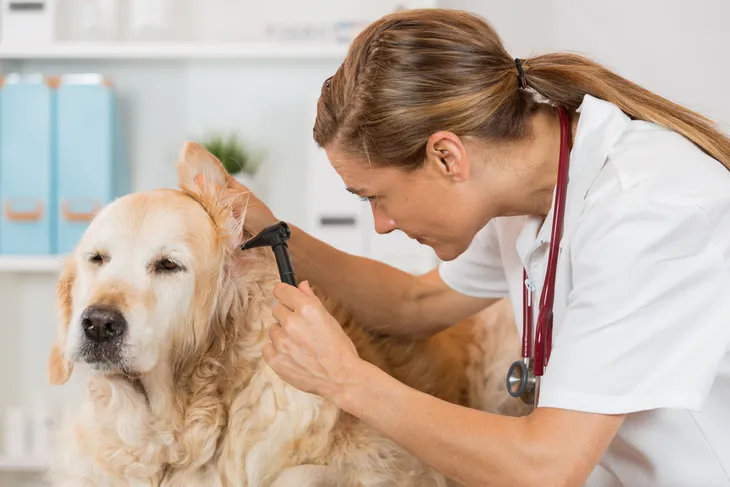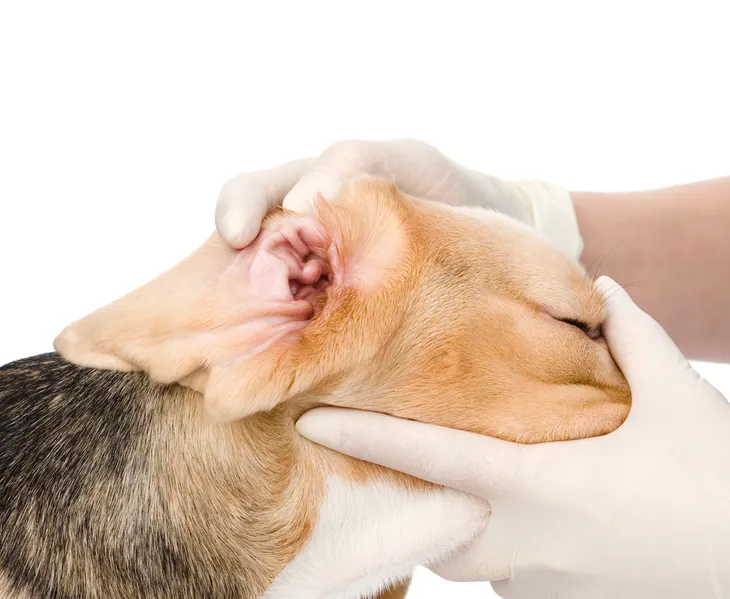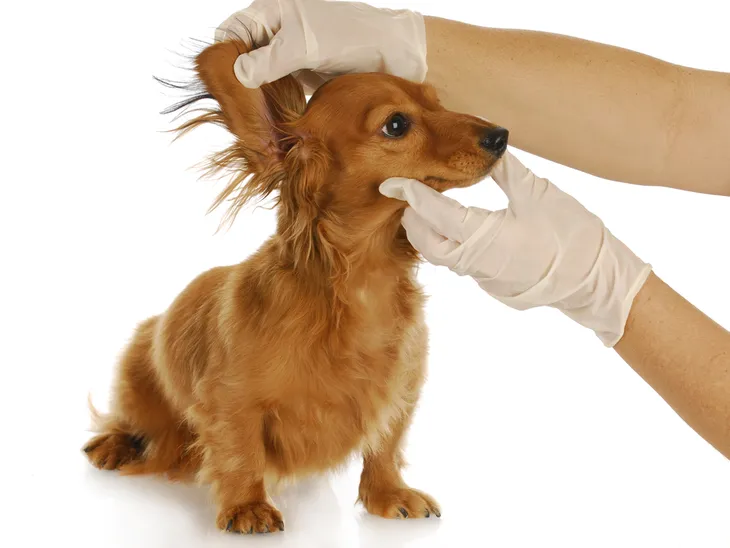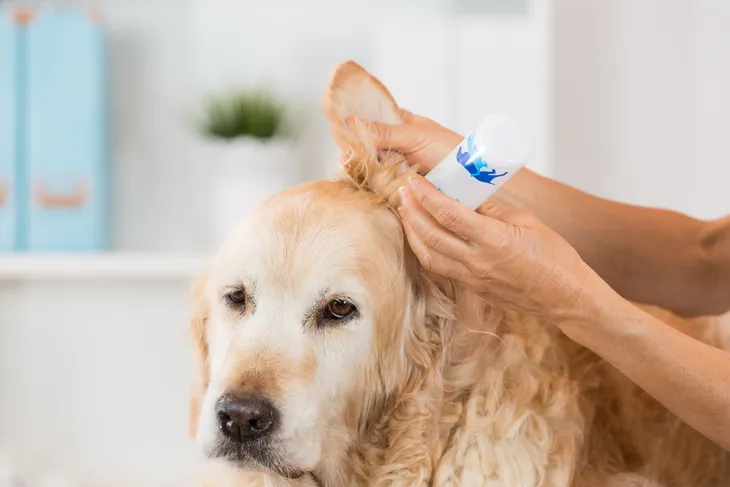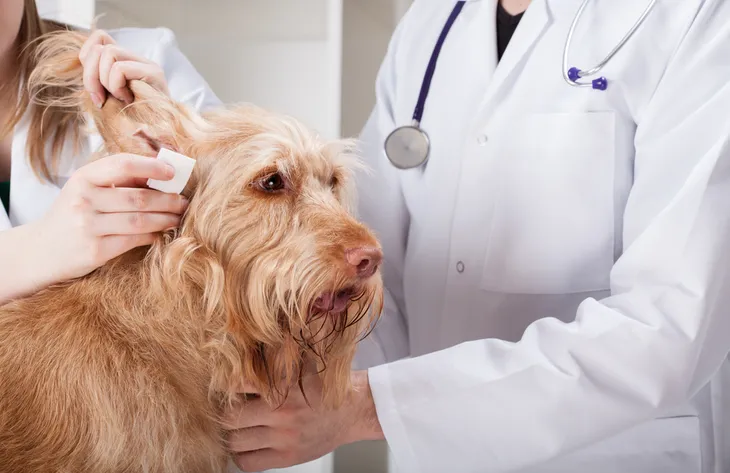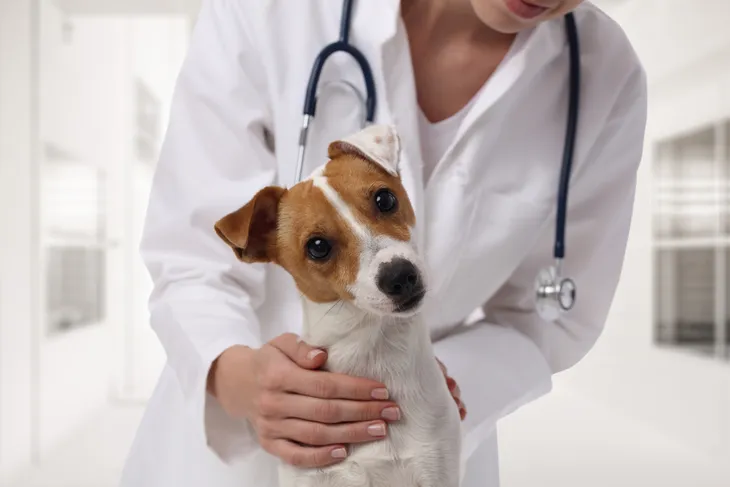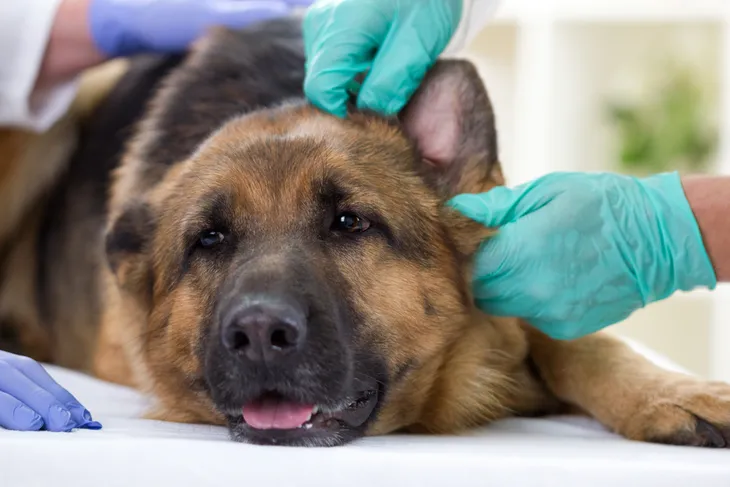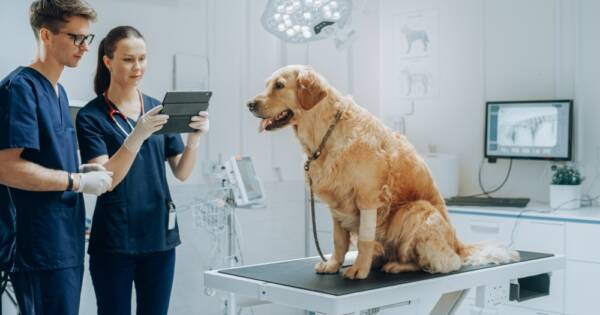Dogs can be affected by two main types of ear infections: otitis media, which is an infection of the middle ear, and otitis externa, which affects the animal’s outer ear. Both types of infection usually have bacterial causes.
While ear infections can be painful for dogs, they are quite common and the good news is that most cases are highly treatable. Breeds with long ears, floppy rather than pointed ears, and large amounts of hair around the ears are more susceptible to ear infections. These breeds tend to get ear infections more frequently.
Symptoms of Ear Infection in Dogs
In dogs, the symptoms of ear infection are usually quite apparent. It’s important to seek prompt veterinary attention if you notice them, because ear infections can worsen quite quickly and cause significant complications (note: treatment options are listed after the 6 symptoms below):
Symptom: Unusual Head Movements
You may notice your dog making unusual head movements if it has an ear infection, such as constantly shaking its head or tilting its head to one side. This is because the dog can feel the presence of a microbial infection in its ear and is trying to shake it loose. Alternately, or in addition to these symptoms, you may also see your dog rubbing its ear on furnishings in your home. Dogs will also scratch at the affected ear, which can make things worse.
Symptom: Visible Discharges From the Ear
If you notice your dog fussing with its ear, try to take a look inside with the help of a flashlight. If you notice a brown or red-colored discharge inside the ear, an ear infection is the likely culprit.
In many cases, this discharge will remain limited to the inner ear. However, in some cases, it can spill out and become visible without the need to look inside the ear.
Symptom: Ear Odors
These brownish or reddish discharges will often be accompanied by an unusual odor, which you may be able to detect even if a colored discharge is not visible. In many cases, this odor will have a strong but sweet smell.
Most of these odors are caused by bacteria, but it is also possible for dogs to get fungal ear infections. Fungal infections often cause a noticeable odor as well, but they tend not to produce discharges the way bacterial infections do.
Symptom: Redness and Swelling
Redness and inflammation (swelling) typically accompany canine ear infections, regardless of whether or not odors or discharges are present. This redness and inflammation will be most readily detectable if your dog has otitis externa, but it may also be visible in cases of otitis media if you’re able to look inside your dog’s ears with a flashlight.
As a word of warning: don’t try to diagnose and treat a possible ear infection yourself, even if you notice symptoms consistent with the condition. Always seek the advice of a veterinarian.
Symptom: Mouth-Related Symptoms
Particularly nasty cases of canine otitis media can cause symptoms related to your pet’s mouth. These symptoms occur as the result of bacterial infection spreading deeper into your dog’s head.
The two most common mouth-related symptoms of a canine ear infection are an apparent unwillingness to bite or chew on things, and apparent discomfort and pain that occurs when your dog opens its mouth. In both cases, your next step should be to make an appointment with your vet.
Symptom: Nervous System Symptoms
Severe and untreated infections of the inner ear may go on to cause symptoms that disrupt your pet’s nervous system. Your dog may develop a wobbly sense of balance, loss of coordination, or unusually wide and unstable bodily movements. The latter symptoms indicate an infection affecting both ears.
In advanced cases, your dog may lose hearing in the affected ear, or develop signs of nervous system damage including paralysis of the face or a loss of ability to blink its eye on the affected side.
Treatment of Ear Infection in Dogs
Most canine ear infections respond well to treatment. Your vet may recommend:
Treatment Option: Antimicrobial Treatments
One of the first things your vet is likely to suggest is to treat the infection with antimicrobial drugs, either topically or systemically. Antibiotics will be used if the infection is bacterial in nature, while antifungal drugs will be prescribed if your dog has a fungal infection. Note that your vet may need to perform tests to accurately identify the exact cause of your pet’s ear infection.
These treatments can usually be carried out at home, and you will administer the drugs. However, in cases of serious infection, your vet may recommend that your pet stay in an animal hospital to undergo treatment.
Treatment Option: Surgical Drainage
If antimicrobial treatments fail to have the desired effect, or if your dog has suffered a succession of ear infections, your vet may opt for a more aggressive strategy. The surgical drainage of the infected ear may be a necessity at this point.
Most bacterial ear infections involve a clustered lump of bacteria, gathered in a localized area of the inner ear. Your vet will pierce the bulbous bacterial mass, drain the bacteria from the ear, then apply a cleansing solution meant to wash the ear clean of any lingering microbes.
Treatment Option: Ear Cleansing
With or without surgery, your vet may also recommend that you cleanse your pet’s ears at home on your own, once treatment is complete and the infection has cleared up. This is usually a simple process that involves filling the dog’s ear canal with a specially formulated cleaning solution, then using a cotton ball to plug the ear shut and absorb the liquid while you perform a gentle massaging motion at the external base of the dog’s ear.
A word of warning: clean your dog’s ear only as often as directed by your vet. Cleansing it too frequently will actually make your pet more prone to developing another infection.
Treatment Option: Re-Evaluation
An important step of the treatment process is a veterinary re-evaluation, which your vet will likely order to be performed about two weeks after treatment. During this visit, your pet’s doctor will conduct a thorough examination of the area that was affected by the infection, looking for subtle signs of a recurrence.
It is important that you take your pet to this re-evaluation, even if its symptoms appear to have completely cleared up. Minor, opportunistic infections can occur in the days and weeks following treatment, and these often cause no noticeable symptoms at first.
Treatment Option: Natural and Holistic Options
In most cases, veterinarians favor medically proven techniques. However, if you like, you can try natural and holistic options for treating a canine ear infection.
Natural canine ear infection remedies include combining apple cider vinegar with water in equal parts, then squirting the mixture into your pet’s affected ear with a syringe. However, you should not use this treatment if your pet is in obvious discomfort, as it may worsen its pain.
A single drop of coconut oil can also be mixed with half an ounce of liquid aloe extract, then applied to your dog’s ear with a dropper. Close off the ear canal with a cotton ball and allow the liquid to absorb.
Before trying any of these treatments, you should consult a homeopathic veterinarian.
Treatment Option: Prevention
Prevention is worth a pound of cure when it comes to canine ear infections. The best preventative measure is to periodically cleanse your dog’s ears using a liquid solution and cotton ball, as described above. It is especially wise to do this after your dog’s ears have been wet, such as after swimming or bathing. Microbes tend to thrive in moist conditions, and it will help a great deal to keep your dog’s ears clean and dry.


